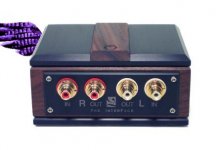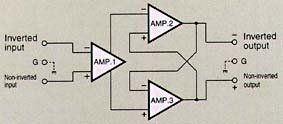Hey Guys,
I am considering my first DIY audio project. I think I want to build an unbalanced to balanced high quality converter to connect my McCormack micro line drive (unbalanced output) to the balanced input of my Odyssey Stratos Amplifier. I saw some op-amp inverter circuits and others using transformers. Does anyone have experience with this? Any schematics or kits available? Any feedback will be appreciated.
Salsero
I am considering my first DIY audio project. I think I want to build an unbalanced to balanced high quality converter to connect my McCormack micro line drive (unbalanced output) to the balanced input of my Odyssey Stratos Amplifier. I saw some op-amp inverter circuits and others using transformers. Does anyone have experience with this? Any schematics or kits available? Any feedback will be appreciated.
Salsero
You might want to look a the SSM-214x series that AD makes. They sound ok, a little rolled off on top. Relatively inexpensive solution.
Another option is a transformer. Expensive, but they have the advantage of galvanic isolation. I've used both Jensen and Lindahl. You can order from Jensen dircet, and Lindahl has a distributor in the US.
In any case, I suggest visting Jensen's site to read the excellent papers that Bill Whitlock has written on high-performance interfaces. That should give you lots of food for thought.
Jocko
Another option is a transformer. Expensive, but they have the advantage of galvanic isolation. I've used both Jensen and Lindahl. You can order from Jensen dircet, and Lindahl has a distributor in the US.
In any case, I suggest visting Jensen's site to read the excellent papers that Bill Whitlock has written on high-performance interfaces. That should give you lots of food for thought.
Jocko
Hey Jocko,Jocko Homo said:Another option is a transformer. Expensive, but they have the advantage of galvanic isolation.
How about one of these.😉
Attachments
Ah, the transformer in a parakeet coffin.
Salsero, I'd go for the transformer if money is not a consideration, an SSM chip if it is. And when you're ready to do it with discrete parts, I've got an interesting circuit.
Salsero, I'd go for the transformer if money is not a consideration, an SSM chip if it is. And when you're ready to do it with discrete parts, I've got an interesting circuit.
roddyama said:
Hey Jocko,
How about one of these.😉
Hehehe. Alas, even I wouldn't recommend that as a solution here. Jensen's input transformers don't have fully balanced outputs. You could balance them with a bit of extra capacitance on one leg, but even then, the 2.34k output impedance wouldn't make for a very good line driver.
The better solution would be an output transformer like the JT-11-DMCF or the DMPC (a PC mount version of the DMCF). However there is one caveat; if the output stage that will be driving the output transformer is capacitor-coupled, because of the small primary inductance, you need a pretty big cap (200-300uF) to prevent low frequency resonance.
se
SY said:Ah, the transformer in a parakeet coffin.
Liar! There are TWO transformers in that parakeet coffin I'll have you know. 🙂
se
Yeah, not enough room left for the poor dead bird:Steve Eddy said:
Liar! There are TWO transformers in that parakeet coffin I'll have you know. 🙂
se
Attachments
Actually perhaps a better solution if one is going to use transformers is to use a pair of input transformers driving the Odyssey's unbalanced inputs (preferably building them into the chassis if possible) and leave the McCormack unbalanced.
Even when fed from a wholly unbalanced source, a good input transformer like the JT-11P-1 will give you 100dB of common-mode noise rejection. Which is far better than most any electronically balanced input can give you when fed from a balanced source under realworld conditions.
With the 11P-1, there's only about a 7dB difference in common-mode rejection between a balanced source and an unbalanced source.
se
Even when fed from a wholly unbalanced source, a good input transformer like the JT-11P-1 will give you 100dB of common-mode noise rejection. Which is far better than most any electronically balanced input can give you when fed from a balanced source under realworld conditions.
With the 11P-1, there's only about a 7dB difference in common-mode rejection between a balanced source and an unbalanced source.
se
Salsero,
I don't want to post just to give you bad news, but the XLR jack on the Stratos isn't really balanced. It's wired with only two pins in parallel with the RCA jack. Sorry.
Mike G.
I don't want to post just to give you bad news, but the XLR jack on the Stratos isn't really balanced. It's wired with only two pins in parallel with the RCA jack. Sorry.
Mike G.
roddyama said:
Yeah, not enough room left for the poor dead bird:
He's not dead. He's just sleeping. 😀
se
This solution from Accuphase pre-amps is also very interesting (see picture). To make it an unbalanced-to-balanced converter, ditch "Amp.1" and tie inverting input of "Amp.2" and non-inverting input of "Amp.3" together as the input.
The "Amp.x" modules are simple discrete unity-gain opamps. Due to the crossed feedback, the circuit even works with one output shorted to ground, delivering the same voltage. In other words, the output is "isolated" from ground.
Used as shown in the picture, the circuit can restore the symmetry of a balanced signal with unequal amplitudes on (+) and (-) lines.
The "Amp.x" modules are simple discrete unity-gain opamps. Due to the crossed feedback, the circuit even works with one output shorted to ground, delivering the same voltage. In other words, the output is "isolated" from ground.
Used as shown in the picture, the circuit can restore the symmetry of a balanced signal with unequal amplitudes on (+) and (-) lines.
Attachments
mike galusha said:I don't want to post just to give you bad news, but the XLR jack on the Stratos isn't really balanced. It's wired with only two pins in parallel with the RCA jack. Sorry.
Well, he can just yank those XLRs and use the space for a couple of input transformers and get himself a really balanced input. 🙂
se
What about a fully differential Op amp
TI makes a fully differential op amp (THS4131) that is really nice. I have tested this on the AP system two and it achieves -117dB or better distortion numbers. TI sample program is nice too. My two pesos.
TI makes a fully differential op amp (THS4131) that is really nice. I have tested this on the AP system two and it achieves -117dB or better distortion numbers. TI sample program is nice too. My two pesos.
Originally posted by Steve Eddy Well, he can just yank those XLRs and use the space for a couple of input transformers and get himself a really balanced input. 🙂
se
Indeed he can. There is plenty of room in there even if he leaves the XLRs. 🙂 I just wanted to make sure he knew the input wasn't balanced before going to too much effort.
Mike G.
AMT-freak said:This solution from Accuphase pre-amps is also very interesting (see picture). To make it an unbalanced-to-balanced converter, ditch "Amp.1" and tie inverting input of "Amp.2" and non-inverting input of "Amp.3" together as the input.
That reminds me of another solution that can be found on page 3 of Jensen's AN-003 application note, Interconnection of Balanced and Unbalanced Equipment.
Just mirror whatever output network is on the unbalanced output and you've got a truly balanced output with no additional active components.
Though a lot of good it'll do him if his amp's don't in fact have balanced inputs.
se
mike galusha said:Indeed he can. There is plenty of room in there even if he leaves the XLRs. 🙂 I just wanted to make sure he knew the input wasn't balanced before going to too much effort.
Well if those XLRs aren't feeding balanced inputs, that's rather misleading given that most folks associate XLRs with balanced lines, as is obviously the case here.
On their Stratos page they don't make any specific claim to their being balanced, but neither do they state that they're unbalanced.
Isn't this the same company that gives you 30 days to decide whether you like their equipment which they say takes 6+ weeks to its "full sonic potential"? 🙂
se
Steve Eddy said:Well if those XLRs aren't feeding balanced inputs, that's rather misleading given that most folks associate XLRs with balanced lines, as is obviously the case here.
Agreed. Not much point (IMO) of having XLR connectors for an unbalanced input. I can say for certain that this is the case, as I have owned these amps.
Isn't this the same company that gives you 30 days to decide whether you like their equipment which they say takes 6+ weeks to its "full sonic potential"? 🙂
Yep. I have met Klaus (the owner of Odyssey) and he is a very good guy. He does state that they don't sound their best for quite a while but reach most of their potential after a couple of weeks. I personally don't think they take 2 months to reach their full potential but I could be wrong. 🙂 Mine seemed to be quite settled down after a week or so.
Mike G.
Yes, Steve........I know....
That the Jensen's are unbalanced input type. Which is why I mentioned that Swedish guy. However, the site is full of good info that he needs to read.
But since he needed an output transformer, then he could use the Jensen's. So there.
Jocko
That the Jensen's are unbalanced input type. Which is why I mentioned that Swedish guy. However, the site is full of good info that he needs to read.
But since he needed an output transformer, then he could use the Jensen's. So there.
Jocko
I never said you didn't know...
What I was responding to roddyama's post where he threw up a photo of my InterFace, which uses input transformers. My reply to that post had nothing to do with anything you'd said in your previous post.
se
Jocko Homo said:That the Jensen's are unbalanced input type. Which is why I mentioned that Swedish guy. However, the site is full of good info that he needs to read.
But since he needed an output transformer, then he could use the Jensen's. So there.
What I was responding to roddyama's post where he threw up a photo of my InterFace, which uses input transformers. My reply to that post had nothing to do with anything you'd said in your previous post.
se
- Status
- Not open for further replies.
- Home
- Amplifiers
- Solid State
- unbalanced to balanced converter


